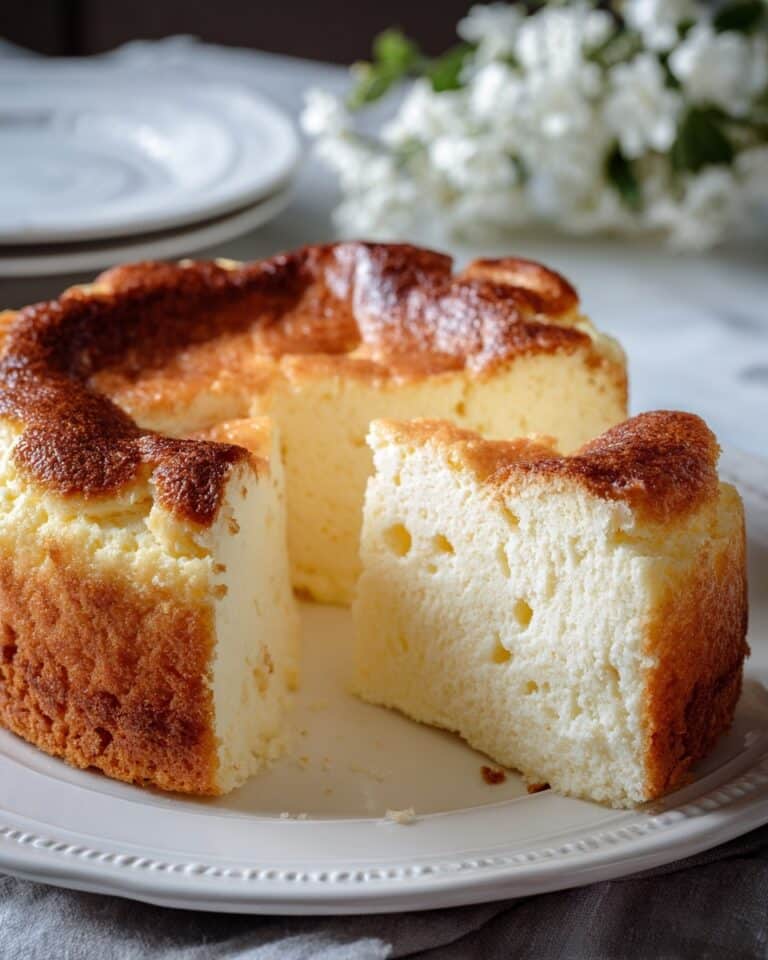GREEK ORANGE CAKE – PORTOKALOPITA Recipe
If you crave a dessert that bursts with sunshine and tradition, then you simply must try the GREEK ORANGE CAKE – PORTOKALOPITA. This delightful cake blends crisp layers of phyllo dough with a luscious, orange-infused syrup that soaks into every crumb. The resulting texture is uniquely crunchy, moist, and tender all at once, making it an irresistible centerpiece for any occasion. Whether you’re a longtime fan of Greek cuisine or just discovering its magic, this cake will bring warmth and vibrant flavor to your kitchen like nothing else.

Ingredients You’ll Need
This recipe shines because of how simple and authentic the ingredients are. Each component plays a vital role in balancing the flavor and texture, giving you that unforgettable taste of GREEK ORANGE CAKE – PORTOKALOPITA. Here’s the rundown:
- Phyllo dough (1 pound/500g): The foundation, providing the signature crisp and flaky layers.
- Greek yogurt (1 cup/200g), strained: Adds moisture and a subtle tang to the cake batter.
- Granulated sugar (for batter and syrup): Sweetens the cake and the syrup, enhancing the bright orange flavors.
- Sunflower oil (1 cup/250ml): Keeps the cake tender without overpowering the orange essence.
- Fresh orange juice (1⅓ cups/350ml total): The star ingredient providing fresh citrus zing.
- Baking powder (2 tablespoons): Ensures a light, airy texture.
- Vanilla extract (1 teaspoon): Rounds out the flavors with a gentle sweetness.
- Orange zest (from 1-3 oranges): Adds concentrated orange fragrance and brightness.
- Cinnamon stick: For a subtly warm note in the syrup.
- Orange peels (from 3 oranges): Infuses the syrup with deep citrus aroma.
- Water (2 cups/500ml): Combines with sugar and orange juice to create the syrup.
- A pinch of salt: Enhances all the flavors in subtle ways.
How to Make GREEK ORANGE CAKE – PORTOKALOPITA
Step 1: Prepare the Syrup
Start by combining sugar, water, fresh orange juice, a cinnamon stick, and orange peels in a pot. Bring this mixture to a gentle boil then set it aside to cool without stirring. This syrup is the heart of the GREEK ORANGE CAKE – PORTOKALOPITA, soaking into the cake to give it that signature moist, zesty punch.
Step 2: Prepare the Phyllo Sheets
Lay out your thawed phyllo sheets on a clean surface and cut them in half. You have two great options for cutting: shred the phyllo into small pieces for a more textured cake, or roll a few sheets together and slice them into strips before twisting into loose nests. Whichever you choose, allow the phyllo to dry a bit by twirling it occasionally so every bit crisps beautifully in the oven.
Step 3: Make the Cake Batter
In a large bowl, whisk together Greek yogurt and orange juice until smooth. Then stir in sunflower oil, sugar, vanilla extract, orange zest, baking powder, and a pinch of salt until fully combined. Gently fold in the prepared phyllo pieces a little at a time—careful not to overmix—to keep that perfect texture in your batter.
Step 4: Bake
Preheat your oven to 340 °F (170 °C) and grease a 9×13 inch (25×32 cm) baking pan. Pour in the batter evenly and place the pan in the upper rack. Bake for about 40-45 minutes until golden brown and a toothpick inserted in the center comes out clean. This step brings the crisp, caramelized crust and tender interior together in perfect harmony.
How to Serve GREEK ORANGE CAKE – PORTOKALOPITA

Garnishes
Once your cake cools slightly, drizzle the cooled orange syrup over the top to infuse it with moisture and shine. Finish it off with a sprinkle of powdered sugar, some extra fresh orange zest, or even a few toasted almonds for a delightful crunch. These simple garnishes elevate the experience and invite you to indulge.
Side Dishes
This cake pairs beautifully with a dollop of whipped cream or Greek yogurt lightly sweetened with honey. For an extra touch, a scoop of vanilla or cinnamon ice cream complements the warm citrus notes perfectly. Pairing it with fresh fruit like sliced oranges or pomegranate seeds also adds color and freshness to the plate.
Creative Ways to Present
For a stunning and fun presentation, serve individual portions in charming ramekins topped with syrup and edible flower petals. Or arrange bite-sized cubes on a beautiful serving platter, perfect for parties or afternoon teas. Even layering the cake with additional syrup-soaked phyllo pieces turns it into a sensational trifle-inspired dessert.
Make Ahead and Storage
Storing Leftovers
Wrap leftover GREEK ORANGE CAKE – PORTOKALOPITA tightly in plastic wrap or store it in an airtight container at room temperature for up to 2 days. This keeps the phyllo crisp while maintaining moistness inside. If your kitchen is very warm, refrigeration can help—but bring it back to room temperature before serving for the best texture.
Freezing
You can freeze the cake, wrapped securely in foil and placed inside a freezer-safe bag, for up to one month. Thaw it overnight in the fridge and warm slightly before serving. Freezing helps preserve its flavor and texture, making it a fantastic make-ahead treat for busy days or unexpected guests.
Reheating
To revive your GREEK ORANGE CAKE – PORTOKALOPITA, gently warm it in a 300 °F (150 °C) oven for 10-15 minutes. This brings back the golden crispiness and fresh orange aroma without drying it out. If reheating from frozen, allow it to thaw first, then warm it up carefully for the best results.
FAQs
Can I use frozen phyllo dough for this recipe?
Absolutely! Just make sure to thaw it completely and handle it gently, so it doesn’t tear. The quality of the phyllo really makes a difference in your GREEK ORANGE CAKE – PORTOKALOPITA texture.
What type of yogurt works best?
Plain, strained Greek yogurt is ideal because it’s thick and creamy, giving the cake moisture and slight tang. Low-fat versions work well too, but avoid anything too watery or flavored.
Can I substitute lemon juice for orange juice?
You could try, but orange juice provides a sweeter, more balanced flavor for Portokalopita. Lemon juice may make the cake taste more tart and change the overall character of this traditional dessert.
Is this cake gluten-free?
Traditional phyllo dough contains wheat flour, so this cake is not gluten-free. However, you might find specialty gluten-free phyllo or try experimenting with other similar textures.
How long does the syrup need to cool before using?
It’s best to let the orange syrup cool completely before pouring it over the hot cake. This prevents the syrup from evaporating too quickly and ensures the cake soaks it up properly, making every bite juicy and flavorful.
Final Thoughts
I can’t recommend the GREEK ORANGE CAKE – PORTOKALOPITA enough — it’s truly a celebration of simple ingredients coming together to create something magical. This cake offers a refreshing citrus twist that is both comforting and exciting, perfect for summer afternoons or festive gatherings. Give it a try, and I promise it will quickly become one of your favorite go-to recipes for a taste of Greece in your own home.
PrintGREEK ORANGE CAKE – PORTOKALOPITA Recipe
Greek Orange Cake, known as Portokalopita, is a moist and fragrant cake made with shredded phyllo dough soaked in a vibrant orange syrup. This traditional Greek dessert combines the citrusy brightness of fresh orange juice and zest with the richness of Greek yogurt and sunflower oil, delivering a luscious texture and refreshing flavor perfect for any occasion.
- Prep Time: 25 minutes
- Cook Time: 45 minutes
- Total Time: 1 hour 10 minutes (including syrup cooling and cake soaking time)
- Yield: 12 servings 1x
- Category: Dessert
- Method: Baking, soaking
- Cuisine: Greek
- Diet: Vegetarian
Ingredients
For the Syrup
- 2 cups (500ml) granulated sugar
- 2 cups (500ml) water
- ⅓ cup (100ml) fresh orange juice
- 1 cinnamon stick
- Orange peels from 3 oranges
For the Cake Batter
- 1 pound (500g) pastry phyllo dough (sheets), thawed if frozen
- 1 cup (200g) strained Greek yogurt, plain or low fat
- 1 cup (220g) granulated sugar
- 1 cup (250ml) sunflower oil
- 1 cup (250ml) fresh orange juice
- 2 tablespoons baking powder
- 1 teaspoon vanilla extract
- Orange zest from 1-3 oranges
- A pinch of salt
Instructions
- Prepare the Syrup: In a pot, combine sugar, water, fresh orange juice, cinnamon stick, and orange peels. Bring to a boil, then set aside and let cool completely without stirring to allow flavors to infuse.
- Prepare the Phyllo Sheets: Remove phyllo dough from packaging, unfold and cut each sheet in half. Stack the halves. Option one: shred phyllo into small pieces and spread evenly on a baking sheet, letting them dry while occasionally twirling for even drying. Option two: cut phyllo into strips by rolling 4-5 sheets tightly and slicing into ½ inch (1 cm) strips, then unravel and twist into nests. Let strips dry, twirling occasionally for even drying.
- Prepare the Cake Batter: Preheat oven to 340°F (170°C) and grease a 9×13 inch (25×32 cm) baking pan. In a mixing bowl, whisk together Greek yogurt and fresh orange juice. Add sunflower oil, sugar, vanilla extract, orange zest, baking powder, and salt, stirring to combine well. Fold phyllo shreds or strips gradually into the wet mixture, taking care not to overmix.
- Bake: Pour batter into the prepared baking pan and place on the upper rack of the oven. Bake for 40-45 minutes or until the cake is golden and a toothpick inserted in the center comes out clean.
- Soak the Cake: As soon as the cake comes out of the oven, pour the cooled syrup evenly over it to allow full absorption for moistness and flavor enhancement. Let cool completely before serving.
Notes
- Ensure the syrup is completely cooled before pouring over the hot cake to prevent it from becoming soggy.
- Straining Greek yogurt helps reduce moisture and contributes to a denser cake texture.
- Phyllo dough can be handled with care to prevent tearing but shredding or cutting before drying is essential for the cake texture.
- Orange zest quantity can be adjusted according to your preference for citrus flavor.
- If unavailable, sunflower oil can be substituted with another mild flavored oil such as canola or vegetable oil.
- This cake improves in flavor after a few hours or overnight chilling, allowing syrup to fully permeate.
Nutrition
- Serving Size: 1 slice (approximately 120g)
- Calories: 350 kcal
- Sugar: 30g
- Sodium: 100mg
- Fat: 18g
- Saturated Fat: 2.5g
- Unsaturated Fat: 15.5g
- Trans Fat: 0g
- Carbohydrates: 42g
- Fiber: 1.5g
- Protein: 4g
- Cholesterol: 5mg
Keywords: Greek orange cake, Portokalopita, phyllo dessert, orange syrup cake, traditional Greek recipe








